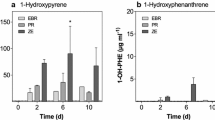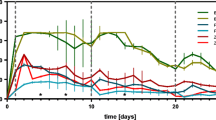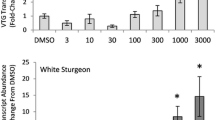Abstract
Guiana dolphin is the top predator of highest toxicological concern in Brazil and many studies on levels of persistent, bioaccumulative, and toxicant (PBT) pollutants have been performed on the species. However, due to high costs of the analyses, only one investigation comprised the determination of dioxins and related compounds (DRCs) in Guiana dolphin tissues. The dioxin responsive-chemically activated luciferase gene expression (DR-CALUX®) cell bioassay was used in the present study for the analyses of hepatic samples from 28 male Guiana dolphins in order to screen estuarine environments for DRCs, comprising three regions (Northeastern, Southeastern, and Southern) and four states [Paraná (PR), Rio de Janeiro (RJ), Espírito Santo (ES), and Ceará (CE)] of Brazil. High bioanalytical equivalent (BEQ) concentrations [dioxins (pg BEQ/g lipid)] were found, varying from 1.94 to 15.6 pg BEQ/g. A significant negative correlation between BEQ concentrations and total length was found in Guiana dolphins from Brazil (all analysed dolphins). This pattern also was verified for RJ state, pointing to (1) chemically induced developmental disruption or to (2) increasing efficiency of the detoxifying activity with the growth of the animal. Comparison was performed with literature data and significantly higher BEQ levels were found in Brazilian Guiana dolphins than in those reported for North Sea harbour porpoises. Higher levels were found in Southeastern (the most PBT-contaminated area of the country) than in Southern region. However, it is not possible to affirm that Guiana dolphins are more contaminated by DRCs in SE than in S region, because individuals were lengthier in S than in SE region. Our results seem to have mirrored dolphin exposure to PCBs in Brazil according to the literature. Further studies are required for investigating the hypotheses 1 and 2 mentioned above.




Similar content being viewed by others
References
Aarts JMMJG, de Haan LHJ, Schalk JAC, Cox MA, Brouwer A (1993) Ah receptor-mediated luciferase expression: a tool for monitoring dioxin-like toxicity. Organohalog Comp 13:361–364
Almeida FV, Centeno AJ, Bisinoti MC, Jardim WF (2007) Persistent toxic substances (PTS) in Brazil. Quim Nova 30:1976–1985
Alonso MB et al (2012a) Natural and anthropogenically produced brominated compounds in endemic dolphins from Western South Atlantic: another risk to a vulnerable species. Environ Pollut 170:152–160
Alonso MB et al (2012b) Pyrethroids: a new threat to marine mammals? Environ Int 47:99–106
Amador EDS (2013) Baía de Guanabara: Ocupação histórica e avaliação ambiental. Interciência 1:78–103
Azevedo AF, Lailson-Brito J, Dorneles PR, van Sluys M, Cunha HA, Fragoso ABL (2009) Human-induced injuries to marine tucuxis (Sotalia guianensis) (Cetacea: Delphinidae) in Brazil. Marine Biodivers Rec 2:1–5
Azevedo-Silva CE et al (2009) Organochlorine compounds in sharks from the Brazilian coast. Mar Poll Bull 58:294–298
Bazzalo M, Flores PAC, Pereira MG (2008) Habitat use and behavior of the marine tucuxi or Guyana dolphin in Baía Norte (Sotalia guianensis, Van Bénéden, 1864), state of Santa Catarina, Brazil. Mastozool Neotrop 15:9–22
Bícego MC et al (2006) Assessment of contamination by polychlorinated biphenyls and aliphatic and aromatic hydrocarbons in sediments of the Santos and São Vicente Estuary System, São Paulo, Brazil. Mar Poll Bull 52:1804–1816. doi:10.1016/j.marpolbul.2006.09.011
Bisi TL et al (2012) Trophic relationships and mercury biomagnification in Brazilian tropical coastal food webs. Eco Indicat 18:291–302
Bittencourt L, Carvalho RR, Lailson-Brito J, Azevedo AF (2014) Underwater noise pollution in a coastal tropical environment. Mar Poll Bull 83:331–336. doi:10.1016/j.marpolbul.2014.04.026
Campos AA, Polette MA (2003) Gestão integrada da zona costeira. In: Campos AA, Monteiro AQ, Monteiro-Neto C, Polette MA (eds) Zona costeira do ceará: diagnóstico para gestão integrada. AQUASIS, Fortaleza, pp 11–25
Carreira RS, Wagener ALR, Readman JW (2004) Sterols as markers of sewage contamination in a tropical urban estuary (Guanabara Bay, Brazil): space-time variations. Estuar Coast Shelf Sci 60:587–598
Carvalho VF (2013) Avaliação dos impactos da urbanização sobre as comunidades de macroalgas bentônicas no litoral do Espírito Santo, Brasil. Master Thesis, Universidade Federal Rural de Pernambuco
Connell DW (1989) Biomagnification by aquatic organisms: a proposal. Chemosphere 19:1573–1584. doi:10.1016/0045-6535(89)90501-8
Cunha HA, Watts PC (2007) Twelve microsatellite loci for marine and riverine tucuxi dolphins (Sotalia guianensis and Sotalia fluviatilis). Molec Ecol Notes 7:1229–1231. doi:10.1111/j.1471-8286.2007.01839.x
Cunha HA et al (2005) Riverine and marine ecotypes of Sotalia dolphins are different species. Mar Biol 148:449–457
Dachs J, Bayona JM, Fowler SW, Miquel JC, Albaiges J (1996) Vertical fluxes of polycyclic aromatic hydrocarbons and organochlorine compounds in the western Alboran Sea (southwestern Mediterranean). Mar Chem 52:75–86. doi:10.1016/0304-4203(95)00084-4
Das K, Debacker V, Pillet S, Bouquegneau J-M (2003) Heavy metals in marine mammals. In: Vos JG, Bossart GD, Fournier M, O’Shea TJ (eds) Toxicology of marine mammals. Taylor and Francis, London, pp 135–167
Das K, Holsbeek L, Jauniaux T (2005) Viability of the Northeast Atlantic harbour porpoise and seal population vol II. Belgian Federal Science Policy Office
Dorneles PR, Lailson-Brito J, dos Santos RA, Silva da Costa PA, Malm O, Azevedo AF, Machado Torres JP (2007) Cephalopods and cetaceans as indicators of offshore bioavailability of cadmium off Central South Brazil Bight. Environ Poll 148:352–359
Dorneles PR et al (2008a) High accumulation of perfluorooctane sulfonate (PFOS) in marine tucuxi dolphins (Sotalia guianensis) from the Brazilian coast. Environ Sci Technol 42:5368–5373. doi:10.1021/es800702k
Dorneles PR et al (2008b) Evaluation of cetacean exposure to organotin compounds in Brazilian waters through hepatic total tin concentrations. Environ Poll 156:1268–1276
Dorneles PR et al (2010) Anthropogenic and naturally-produced organobrominated compounds in marine mammals from Brazil. Environ Int 36:60–67
Dorneles PR et al (2013) High accumulation of PCDD, PCDF, and PCB congeners in marine mammals from Brazil: a serious PCB problem. Sci Total Environ 463–464:309–318
Dorneles PR et al (2015) Levels and profiles of chlorinated and brominated contaminants in Southern Hemisphere humpback whales, Megaptera novaeangliae. Environ Res 138:49–57. doi:10.1016/j.envres.2015.02.007
Geraci JR, Lounsbury VJ, William FP, Bernd W, Thewissen JGM (2009) Health. Encyclopedia of marine mammals, 2nd edn. Academic Press, London, pp 546–553
Gobas FAPC, Morrison HA (2000) Bioconcentration and bioaccumulation in the aquatic environment. In: Boethling RMD (ed) Handbook of property estimation methods for chemicals: environmental and health sciences. CRC Press LLC, Boca Raton, pp 189–231
Gobas FAPC, De Wolf W, Burkhard LP, Verbruggen E, Plotzke K (2009) Revisiting bioaccumulation criteria for POPs and PBT assessments. Integr Environ Assess Manag 5:624–637. doi:10.1897/IEAM_2008-089.1
Gray JS (2002) Biomagnification in marine systems: the perspective of an ecologist. Mar Pollut Bull 45:46–52
Hall AJ (2002) Organohalogenated contaminants in marine mammals. In: Evans PGH, Raga JA (eds) Marine mammals: biology and conservation. Kluwer Academic/Plenum Publishers, New York, pp 523–563
Isobe T et al (2009) Organohalogen contaminants in striped dolphins (Stenella coeruleoalba) from Japan: present contamination status, body distribution and temporal trends (1978–2003). Mar Poll Bull 58:396–401. doi:10.1016/j.marpolbul.2008.10.008
Jonker MTO, Koelmans AA (2002) Sorption of polycyclic aromatic hydrocarbons and polychlorinated biphenyls to soot and soot-like materials in the aqueous environment mechanistic considerations. Environ Sci Technol 36:3725–3734. doi:10.1021/es020019x
Kajiwara N, Matsuoka S, Iwata H, Tanabe S, Rosas FCW, Fillmann G, Readman JW (2004) Contamination by persistent organochlorines in cetaceans incidentally caught along Brazilian coastal waters. Arch Environ Contamin Toxicol 46:124–134. doi:10.1007/s00244-003-2239-y
Kunisue T, Watanabe MX, Iwata H, Tsubota T, Yamada F, Yasuda M, Tanabe S (2006) PCDDs, PCDFs, and coplanar PCBs in wild terrestrial mammals from Japan: congener specific accumulation and hepatic sequestration. Environ Poll 140:525–535
Kunito T et al (2004) Concentration and subcellular distribution of trace elements in liver of small cetaceans incidentally caught along the Brazilian coast. Mar Poll Bull 49:574–587
Lailson-Brito J et al (2010) High organochlorine accumulation in blubber of Guiana dolphin, Sotalia guianensis, from Brazilian coast and its use to establish geographical differences among populations. Environ Poll 158:1800–1808
Lailson-Brito J et al (2011) Organochlorine concentrations in franciscana dolphins, Pontoporia blainvillei, from Brazilian waters. Chemosphere 84:882–887
Lailson-Brito J et al (2012a) Mercury-Selenium relationships in liver of Guiana Dolphin: The possible role of Kupffer cells in the detoxification process by Tiemannite formation. PLoS One. doi:10.1111/j.1523-1739.2012.01934.x
Lailson-Brito J et al (2012b) Organochlorine compound accumulation in delphinids from Rio de Janeiro State, southeastern Brazilian coast. Sci Total Environ 433:123–131
Law RJ, Barry J, Bersuder P, Barber JL, Deaville R, Reid RJ, Jepson PD (2010a) Levels and Trends of Brominated Diphenyl Ethers in Blubber of Harbor Porpoises (Phocoena phocoena) from the U.K., 1992–2008. Environ Sci Tech 44:4447–4451. doi:10.1021/es100140q
Law RJ, Bersuder P, Barry J, Deaville R, Reid RJ, Jepson PD (2010b) Chlorobiphenyls in the blubber of harbour porpoises (Phocoena phocoena) from the UK: levels and trends 1991–2005. Mar Poll Bull 60:470–473. doi:10.1016/j.marpolbul.2009.12.003
Legat LNA (2011) Organochlorine compound (PCBs, DDTs and HCB) accumulation in hepatic tissues of delphinids (Cetacea, Mammalia) from Rio de Janeiro state. Master Thesis, Rio de Janeiro State University (UERJ)
Lewontin RC (1974) The genetic basis of evolutionary change. Columbia University Press, New York
Matthews LH (1978) The natural history of the whale. Columbia University Press, New York
Meirelles ACOD (2013) Ecologia populacional e comportamento do boto-cinza, Sotalia guianensis (van Bénéden, 1864), na enseada do Mucuripe, Fortaleza, estado do Ceará. Doctoral Dissertation, Universidade Federal do Ceara
O’Shea TJ, Tanabe S (2003) Persistent ocean contaminants and marine mammals: a retrospective overview. In: Vos JG, Bossart GD, Fournier M, O’Shea TJ (eds) Toxicology of marine mammals. Taylor and Francis, London, pp 99–134
O’Shea TJ, Brownell RL Jr (1994) Organochlorine and metal contaminants in baleen whales: a review and evaluation of conservation implications. Sci Total Environ 154:179–200
Quinete N, Wu Q, Zhang T, Yun SH, Moreira I, Kannan K (2009) Specific profiles of perfluorinated compounds in surface and drinking waters and accumulation in mussels, fish, and dolphins from southeastern Brazil. Chemosphere 77:863–869
Quinete N, Lavandier R, Dias P, Taniguchi S, Montone R, Moreira I (2011) Specific profiles of polybrominated diphenylethers (PBDEs) and polychlorinated biphenyls (PCBs) in fish and tucuxi dolphins from the estuary of ParaÃba do Sul River, Southeastern Brazil. Mar Poll Bull 62:440–446
Reijnders PJH (2003) Reproductive and developmental effects of environmental organochlorines on marine mammals. In: Vos JG, Bossart GD, Fournier M, O’Shea TJ (eds) Toxicology of marine mammals. Taylor and Francis, London, pp 55–66
Reijnders PJH, Aguilar A, Borrell A, William FP, Bernd W, Thewissen JGM (2009) Pollution and marine mammals. Encyclopedia of marine mammals, 2nd edn. Academic Press, London, pp 890–898
Rodrigues EM, Ramos ABA, Cabrini TMB, Dos Santos Fernandez MA (2015) The occurrence of polybrominated diphenyl ethers in Brazil: a review. Int J Environ Health 7:247–266. doi:10.1504/IJENVH.2015.073202
Rosas FCW, Barreto AS, Monteiro-Filho ELdA (2003) Age and growth of the estuarine dolphin (Sotalia guianensis) (Cetacea, Delphinidae) on the Paraná coast, southern Brazil. Fish Bull 101:377–383
Sanderson JT, Van Den Berg M (1999) Toxic equivalency factors (TEFs) and their use in ecological risk assessment: a successful method when used appropriately. Hum Ecol Risk Assess 5:43–52
Santos-Neto EB et al (2014) Organochlorine concentrations (PCBs, DDTs, HCHs, HCB and MIREX) in delphinids stranded at the northeastern Brazil. Sci Total Environ 472:194–203. doi:10.1016/j.scitotenv.2013.10.117
Scippo ML, Eppe G, De Pauw E, Maghuin-Rogister G (2004) DR-CALUX((R)) screening of food samples: evaluation of the quantitative approach to measure dioxin, furans and dioxin-like PCBs. Talanta 63:1193–1202. doi:10.1016/j.talanta.2004.05.037
Scippo ML, Rybertt S, Eppe G, Massart AC, De Pauw E, Maghuin-Rogister G (2006) Dioxin analysis in feed: cell-based assay versus mass spectrometry method. Accred Qual Assur 11:38–43. doi:10.1007/s00769-005-0073-9
Seixas TG, Kehrig HA, Di Beneditto APM, Souza CMM, Malm O, Moreira I (2009) Essential (Se, Cu) and non-essential (Ag, Hg, Cd) elements: what are their relationships in liver of Sotalia guianensis (Cetacea, Delphinidae)? Mar Poll Bull 58:629–634
SEMADS (2001) Ambiente das águas no Estado do Rio de Janeiro, cooperação técnica Brasil-Alemanha, Projeto PLANÁGUA-SEMADS/GTZ. SEMADS, Rio de Janeiro
Souza ASd, Torres JPM, Meire RO, Neves RC, Couri MS, Serejo CS (2008) Organochlorine pesticides (OCs) and polychlorinated biphenyls (PCBs) in sediments and crabs (Chasmagnathus granulata, Dana, 1851) from mangroves of Guanabara Bay, Rio de Janeiro State, Brazil. Chemosphere 73:S186–S192. doi:10.1016/j.chemosphere.2007.04.093
Sun J, Wang MH, Ho YS (2012) A historical review and bibliometric analysis of research on estuary pollution. Mar Poll Bull 64:13–21. doi:10.1016/j.marpolbul.2011.10.034
Thron KU, Bruhn R, McLachlan MS (2004) The influence of age, sex, body-condition, and region on the levels of PBDEs and toxaphene in harbour porpoises from European waters. Fresenius Environ Bull 13:146–155
Van den Berg M et al (2006) The 2005 World Health Organization reevaluation of human and mammalian toxic equivalency factors for dioxins and dioxin-like compounds. Toxicol Sci 93:223–241. doi:10.1093/toxsci/kfl055
Yogui GT, De Oliveira Santos MC, Montone RC (2003) Chlorinated pesticides and polychlorinated biphenyls in marine tucuxi dolphins (Sotalia fluviatilis) from the Cananéia estuary, southeastern Brazil. Sci Total Environ 312:67–78. doi:10.1016/S0048-9697(03)00198-0
Yogui GT, Santos MCO, Bertozzi CP, Montone RC (2010) Levels of persistent organic pollutants and residual pattern of DDTs in small cetaceans from the coast of São Paulo, Brazil. Mar Poll Bull 60:1862–1867. doi:10.1016/j.marpolbul.2010.07.022
Yogui GT, Santos MCO, Bertozzi CP, Sericano JL, Montone RC (2011) PBDEs in the blubber of marine mammals from coastal areas of São Paulo, Brazil, southwestern Atlantic. Mar Poll Bull 62:2666–2670. doi:10.1016/j.marpolbul.2011.09.024
Acknowledgments
This work was part of a set of investigations included in the scientific mission of Dr. Dorneles (UFRJ Professor), as Visiting Professor at ULg, financed by FNRS (Fonds de la Recherche Scientifique). This work was supported by the Ministry of Education of Brazil-CAPES (“Ciências do Mar”-Proc. 23038.051661/2009-18), by a scientific cooperation established between CNPq (Conselho Nacional de Desenvolvimento Científico e Tecnológico) and FNRS (Proc. 490279/2013-9 CNPq), in which a PDE grant is included for the post-doctoral investigations of Dr. Dorneles (UFRJ Professor; Proc. 203074/2014-9 CNPq) at the University of Liege in 2015, as well as by FAPERJ (Fundação de Amparo à Pesquisa do Estado do Rio de Janeiro, CNE grant of Dr. Malm). Dr. Das is a F.R.S.-FNRS research associate. This is a MARE publication 333. Dr. Azevedo and Dr. Lailson-Brito have research grants from CNPq (PQ-1D) and FAPERJ (JCNE). The rescue of Guiana dolphin carcasses by AQUASIS team was performed in the context of Projeto Manati, which is sponsored by Petrobras.
Author information
Authors and Affiliations
Corresponding author
Rights and permissions
About this article
Cite this article
Dorneles, P.R., Lailson-Brito, J., Bisi, T.L. et al. Guiana Dolphins (Sotalia guianensis) and DR-CALUX for Screening Coastal Brazilian Environments for Dioxins and Related Compounds. Arch Environ Contam Toxicol 71, 336–346 (2016). https://doi.org/10.1007/s00244-016-0299-z
Received:
Accepted:
Published:
Issue Date:
DOI: https://doi.org/10.1007/s00244-016-0299-z




